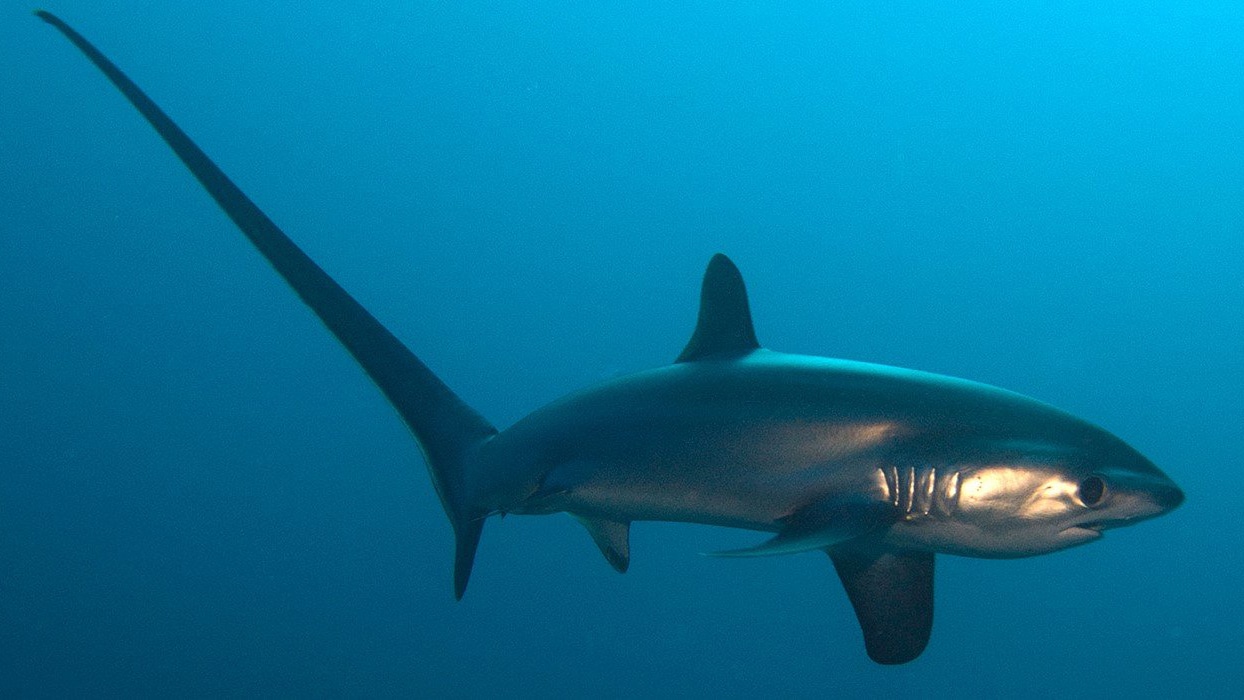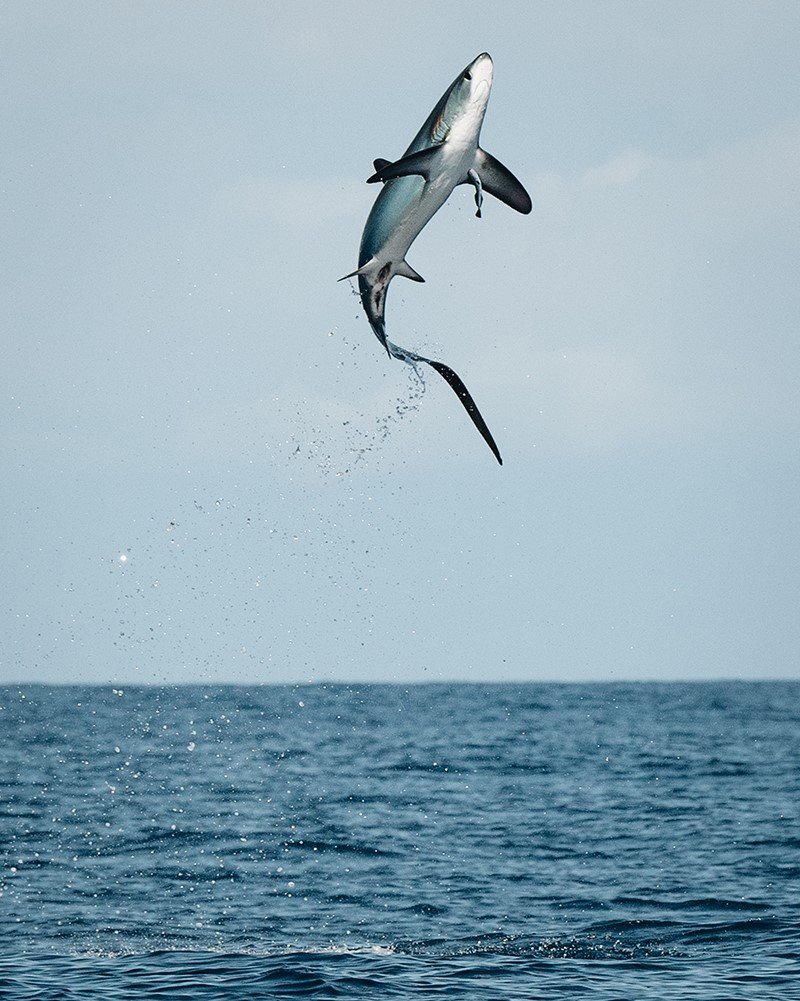Marine Life & Conservation Blogs
Creature Feature: Thresher Sharks

 In this new series, the Shark Trust will be sharing amazing facts about different species of sharks and what you can do to help protect them.
In this new series, the Shark Trust will be sharing amazing facts about different species of sharks and what you can do to help protect them.
This month they’re showcasing the super agile, fish-herding, thresher sharks. Made up of 3 different species, these sharks can whip up dinner at lightning speed…
Thresher Sharks are found in tropical and temperate seas all over the world. Highly migratory, they spend their time in coastal waters as well as the wide-open ocean. By day you’ll likely find them in deep waters, avoiding predators and dining on squid and octopus. But at night, they rise to the surface to hunt small fish.
During daylight hours they may also indulge in a spa. Taking regular trips into shallow coastal waters to visit cleaning stations. Here they get preened and pampered by hungry cleaner fish, who remove pesky parasites picked up during their long travels.
Yet, they are capable of doing this themselves. When cleaner fish are off duty, threshers will remove parasites by breaching out of the water. Check out the photo below – what an incredible sight to see!
To survive in cold deep waters, threshers – like the White Shark and Shortfin Mako – are endothermic. They have a network of tiny blood capillaries, which acts as a heat exchange system. Known as a rete mirabile, this keeps them nice and toasty. In fact, their body temperature can be 10°C warmer than the surrounding water.
But the most distinctive and exciting adaptation of thresher sharks is – of course – their incredibly long, whip-like tail. Shaped like a scythe, this marks impending doom for schooling fish. Making up around half the length of their entire body, their tails can reach up to 3m long! And they’re not just for show…
Hunting in small packs, threshers will use their tail to herd small shoaling fish – such as mackerel, herring and sardines. They’ll then charge into the shoal, thrashing their powerful tail, injuring and stunning their prey. Dazed and confused fish are then swiftly eaten. Larger individuals will also feed on bigger fish, like cod and tuna, as well as large deep-sea squid.
The first part of the thresher sharks’ scientific name is ‘Alopias’, which is Greek for fox. In ancient Greece, the philosopher Aristotle thought these sharks must have been as clever as a fox to avoid the nets and traps of fishermen. But sadly, this isn’t the case today. Due to modern destructive fishing practices, all 3 thresher shark species now face a high risk of extinction.
COMMON THRESHER SHARK:
Bluish to dark grey in colour, the Common Thresher has a pointed snout and small arched mouth.
Depending on the region, females reach maturity between 3 and 13 years. Males between 3 and 8 years. Females will give birth to litters of 2-6 pups in spring/summer, which can be as large as 1.5m! They’re thought to live up to 38 years.
- SCIENTIFIC NAME: Alopias vulpinus
- FAMILY: Alopiidae
- MAXIMUM SIZE: 5.8m
- DIET: Fish and squid.
- DISTRIBUTION: Most tropical and temperate seas around the world. They have a higher tolerance for cold water, than other thresher shark species.
- HABITAT: Coastal waters to the open ocean, from the surface to 650m deep.
- CONSERVATION STATUS: Vulnerable
BIGEYE THRESHER SHARK:
As their name suggests Bigeye Threshers have enormous eyes. These help them navigate and hunt in deep dark waters, and at night. Their eyes can be up to 10cm in diameter and sit within a keyhole-shaped socket, enabling them to rotate their eyes upwards.
Purple to brown-grey in colour, they have the most beautiful metallic hues on their back and flanks.
After a 12-month gestation period, females will give birth to litters of 2 (rarely 4) pups. These can be up to 1.4m long and may live up to 20 years.
- SCIENTIFIC NAME: Alopias pelagicus
- FAMILY: Alopiidae
- MAXIMUM SIZE: 4.8m
- DIET: Fish and squid.
- DISTRIBUTION: Most tropical and temperate seas around the world.
- HABITAT: Coastal waters to the open ocean, from the surface to 500m deep (usually 100m).
- CONSERVATION STATUS: Vulnerable
PELAGIC THRESHER SHARK:
Out of the 3 species, Pelagic Threshers are the smallest and least well-known. Similar in colour to the Bigeye but lighter. They give birth to litters of 2 pups every year and are thought to live around 19 years.
- SCIENTIFIC NAME: Alopias pelagicus
- FAMILY: Alopiidae
- MAXIMUM SIZE: 3.6m
- DIET: Fish and squid.
- DISTRIBUTION: Indo-Pacific Ocean
- HABITAT: Coastal waters to the open ocean, from the surface to 300m deep.
- CONSERVATION STATUS: Endangered
 Discover more with the Thresher Shark Activity Bundle. Brought to you by award-winning outdoor education provider – The Great Out-Tours.
Discover more with the Thresher Shark Activity Bundle. Brought to you by award-winning outdoor education provider – The Great Out-Tours.
Created for children and adults in care homes, these bundles of fun will provide hours of entertainment.
Wordsearches, jigsaws, arts and crafts, educational videos, a family quiz and so much more. All jammed packed into this bundle for just £1, with 15p going to the Shark Trust!
Image banner: Thresher Shark © Matt Newell
Marine Life & Conservation Blogs
Creature Feature: Dusky Shark

 In this series, the Shark Trust will be sharing amazing facts about different species of sharks and what you can do to help protect them.
In this series, the Shark Trust will be sharing amazing facts about different species of sharks and what you can do to help protect them.
This month we’re taking a look at the Dusky Shark, a highly migratory species with a particularly slow growth rate and late age at maturity.
Dusky sharks are one of the largest species within the Carcharhinus genus, generally measuring 3 metres total length but able to reach up to 4.2 metres. They are grey to grey-brown on their dorsal side and their fins usually have dusky margins, with the darkest tips on the caudal fin.
Dusky Sharks can often be confused with other species of the Carcharhinus genus, particularly the Galapagos Shark (Carcharhinus galapagensis). They have very similar external morphology, so it can be easier to ID to species level by taking location into account as the two species occupy very different ecological niches – Galapagos Sharks prefer offshore seamounts and islets, whilst duskies prefer continental margins.
Hybridisation:
A 2019 study found that Dusky Sharks are hybridising with Galapagos Sharks on the Eastern Tropical Pacific (Pazmiño et al., 2019). Hybridisation is when an animal breeds with an individual of another species to produce offspring (a hybrid). Hybrids are often infertile, but this study found that the hybrids were able to produce second generation hybrids!
Long distance swimmers:
Dusky sharks are highly mobile species, undertaking long migrations to stay in warm waters throughout the winter. In the Northern Hemisphere, they head towards the poles in the summer and return southwards towards the equator in winter. The longest distance recorded was 2000 nautical miles!
Very slow to mature and reproduce:
The Dusky Shark are both targeted and caught as bycatch globally. We already know that elasmobranchs are inherently slow reproducers which means that they are heavily impacted by overfishing; it takes them so long to recover that they cannot keep up with the rate at which they are being fished. Dusky Sharks are particularly slow to reproduce – females are only ready to start breeding at roughly 20 years old, their gestation periods can last up to 22 months, and they only give birth every two to three years. This makes duskies one of the most vulnerable of all shark species.
The Dusky Shark is now listed on Appendix II of the Convention on the Conservation of Migratory Species (CMS), but further action is required to protect this important species.
Scientific Name: Carcharhinus obscurus
Family: Carcharhinidae
Maximum Size: 420cm (Total Length)
Diet: Bony fishes, cephalopods, can also eat crustaceans, and small sharks, skates and rays
Distribution: Patchy distribution in tropical and warm temperate seas; Atlantic, Indo-Pacific and Mediterranean.
Habitat: Ranges from inshore waters out to the edge of the continental shelf.
Conservation status: Endangered.
For more great shark information and conservation visit the Shark Trust Website
Images: Andy Murch
Diana A. Pazmiño, Lynne van Herderden, Colin A. Simpfendorfer, Claudia Junge, Stephen C. Donnellan, E. Mauricio Hoyos-Padilla, Clinton A.J. Duffy, Charlie Huveneers, Bronwyn M. Gillanders, Paul A. Butcher, Gregory E. Maes. (2019). Introgressive hybridisation between two widespread sharks in the east Pacific region, Molecular Phylogenetics and Evolution 136(119-127), https://doi.org/10.1016/j.ympev.2019.04.013.
Marine Life & Conservation Blogs
Creature Feature: Undulate Ray

 In this series, the Shark Trust will be sharing amazing facts about different species of sharks and what you can do to help protect them.
In this series, the Shark Trust will be sharing amazing facts about different species of sharks and what you can do to help protect them.
This month we’re looking at the Undulate Ray. Easily identified by its beautiful, ornate pattern, the Undulate Ray gets its name from the undulating patterns of lines and spots on its dorsal side.
This skate is usually found on sandy or muddy sea floors, down to about 200 m deep, although it is more commonly found shallower. They can grow up to 90 cm total length. Depending on the size of the individual, their diet can range from shrimps to crabs.
Although sometimes called the Undulate Ray, this is actually a species of skate, meaning that, as all true skates do, they lay eggs. The eggs are contained in keratin eggcases – the same material that our hair and nails are made up of! These eggcases are also commonly called mermaid’s purses and can be found washed up on beaches all around the UK. If you find one, be sure to take a picture and upload your find to the Great Eggcase Hunt – the Shark Trust’s flagship citizen science project.
It is worth noting that on the south coasts, these eggcases can be confused with those of the Spotted Ray, especially as they look very similar and the ranges overlap, so we sometimes informally refer to them as ‘Spundulates’.
Scientific Name: Raja undulata
Family: Rajidae
Maximum Size: 90cm (total length)
Diet: shrimps and crabs
Distribution: found around the eastern Atlantic and in the Mediterranean Sea.
Habitat: shelf waters down to 200m deep.
Conservation Status : As a commercially exploited species, the Undulate Ray is a recovering species in some areas. The good thing is that they have some of the most comprehensive management measures of almost any elasmobranch species, with both minimum and maximum landing sizes as well as a closed season. Additionally, targeting is entirely prohibited in some areas. They are also often caught as bycatch in various fisheries – in some areas they can be landed whilst in others they must be discarded.
IUCN Red List Status: Endangered
For more great shark information and conservation visit the Shark Trust Website
Image Credits: Banner – Sheila Openshaw; Illustration – Marc Dando
-

 News3 months ago
News3 months agoHone your underwater photography skills with Alphamarine Photography at Red Sea Diving Safari in March
-

 News3 months ago
News3 months agoCapturing Critters in Lembeh Underwater Photography Workshop 2024: Event Roundup
-

 Marine Life & Conservation Blogs3 months ago
Marine Life & Conservation Blogs3 months agoCreature Feature: Swell Sharks
-

 Blogs2 months ago
Blogs2 months agoMurex Resorts: Passport to Paradise!
-

 Blogs2 months ago
Blogs2 months agoDiver Discovering Whale Skeletons Beneath Ice Judged World’s Best Underwater Photograph
-

 Gear Reviews2 weeks ago
Gear Reviews2 weeks agoGEAR REVIEW – Revolutionising Diving Comfort: The Sharkskin T2 Chillproof Suit
-

 Marine Life & Conservation2 months ago
Marine Life & Conservation2 months agoSave the Manatee Club launches brand new webcams at Silver Springs State Park, Florida
-

 Gear Reviews3 months ago
Gear Reviews3 months agoGear Review: Oceanic+ Dive Housing for iPhone























